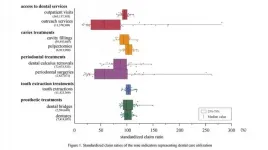(Press-News.org) Does evolution explain why we can't resist a salty chip? Researchers at NC State University found that differences between the elemental composition of foods and the elemental needs of animals can explain the development of pleasing tastes like salty, umami and sweet.
Taste tells us a lot about foods before they are swallowed and digested, and some tastes correspond with the elemental composition of foods. For example, an aged steak lights up the umami taste receptors, because it has a high concentration of the element nitrogen, which occurs in amino acid molecules. Nitrogen is essential for survival, but often occurs in low concentrations relative to the demand by animals. Likewise, sodium is limited in many foods in nature - think of life before supermarkets. So if you need sodium to survive - and all animals do - you are more likely to have adapted a taste for, and seek out, salty foods.
"Nutritional imbalances, even at the elemental level, can limit the growth and metabolism of animals," says Lee Demi, a co-author of the study and postdoctoral researcher in NC State's Department of Applied Ecology. "We posited that animals should have evolved the ability to taste, and enjoy, certain elements and nutrients that are most likely to be limiting for growth, due to their low concentrations in typical foods."
To investigate this hypothesis, Demi and colleagues compared the body elemental composition of three animal groups (mammals, fish, and insects) to the elemental composition of plants, the base of most food webs. They predicted that animals who eat foods composed of particular elements that are rare or unpredictable are more likely to have taste receptors that reward them for finding those same elements.
"Because animals have very limited ability to change their elemental composition, the old adage that 'You are what you eat' doesn't really apply," says Demi. "Rather, animals are rewarded with pleasing tastes for 'eating what they are', at least from an elemental composition perspective, which helps reduce the prospect of dietary nutrient limitation."
This is particularly important for omnivorous and herbivorous animals that eat a variety of different foods which vary in nutritional quality. Within this framework, taste becomes a tool that helps consumers prioritize which foods they should search for and consume, so they don't waste time on foods that have less of these necessary elements. Equally, taste can also inform consumers to avoid foods that contain too much of an element they need. This is why eating a handful of chips is more attractive than eating a handful of table salt.
Where you are on the food chain can predict the complexity of your taste systems. Some top predators, like orcas, have lost many taste receptors over evolutionary time. This study suggests that predators are less likely to experience strong elemental imbalances in their diet than herbivores or omnivores. Because their prey already match their elemental needs, predators experience less selective pressure to maintain elaborate taste systems. However, these top predators have kept their taste for salt, which can be harmful if overconsumed.
"Affinity for certain foods must have strong evolutionary drivers, because without taste, animals would be forced to overconsume everything in the hopes of hitting the magic ratio of elements needed for growth and development," says Benjamin Reading, co-author of the study and a professor in NC State's Department of Applied Ecology. "They would need to eat way too much and end up excreting huge quantities of those things they need less of, which is not efficient."
The research team also found strong evidence of convergent taste evolution in mammals, fish, and insects. Each group, although far apart on the phylogenetic tree, all have adapted tastes that prioritize the same infrequent elements, including sodium, nitrogen and phosphorus.
"Phosphorus is particularly intriguing because this recently discovered taste is most strongly linked to phosphate, which is also the primary form of phosphorus in many nucleic acids, ATP, phospholipids, etc.," says Brad Taylor, a co-author of the study and professor in NC State's Department of Applied Ecology. "Phosphate is the most readily available form of phosphorus for uptake by plants, and often the primary growth limiting element in organisms and ecosystems. So, links between the elemental form, taste receptors, organismal needs, and ecosystem are really direct."
While the neurobiological process of taste has been extensively researched, this study is the first to explore taste as an evolutionary tool for optimal foraging. The researchers suggest that this may open a new area of thought on how taste can indicate how animals impact their environments through foraging, nutrient-cycling, and other core principles of ecology.
INFORMATION:
The paper, "Understanding the evolution of nutritive taste in animals: Insights from biological stoichiometry and nutritional geometry," is published in the journal Ecology and Evolution. The paper was co-authored by Michael Tordoff of the Monell Chemical Senses Center; and Rob Dunn from NC State's Department of Applied Ecology and the Natural History Museum of Denmark.
The work was supported by the U.S. National Science Foundation [grant number 1556914] as well as the Department of Applied Ecology and Dr. Jules Silverman at North Carolina State University.
(Boston)-- The concept of rationing medical resources during the height of COVID-19 pandemic created tremendous anxiety in the patient and healthcare communities. In planning for that possibility Massachusetts created a triage scoring system focusing on an acute survival score that considers chronic life-limiting medical conditions of the patient, but it does not provide specifics about how to value those conditions in the equation.
Now a new study supports prioritizing resources to those who are most likely to survive an acute illness as several chronic medical conditions had less of an impact on longer-term survival than previously suspected.
"No one ...
(Boston)--Despite evidence regarding the benefits of vaginal birth after cesarean and recommendations to support shared decision making to reduce cesarean rates, minority women face many impediments that limit their access to appropriate health information and opportunities for such discussions.
Haitian women in Massachusetts have the highest rates of cesarean section and low rates of vaginal birth after cesarean, despite evidence suggesting that many are eligible to attempt vaginal birth after a previous cesarean.
Now a new study explores how Haitian women's beliefs, values and attitudes influence their decision making about pregnancy and birth after having had a cesarean delivery. In conjunction with the providers' views about Haitian women, the information ...
Farmed foxes selectively bred for tameness and aggressiveness exhibit similar changes to their brain anatomy, according to research recently published in JNeurosci. Both lineages also have larger brains than conventional farm-bred foxes, complicating leading theories on domestication.
Domesticated species provide insight into complex evolutionary processes on a condensed timeframe. When a species splits from its wild counterpart, its brain, body, and behavior undergo rapid changes. Studies with chickens, sheep, cats, dogs, and more indicate domestication shrinks the brain. But the same pattern does not extend to foxes in the expected way.
Hecht et al. used MRI to measure the brain size ...
When Erin Hecht was earning her Ph.D. in neuroscience more than a decade ago, she watched a nature special on the Russian farm-fox experiment, one of the best-known studies on animal domestication.
The study, running since 1958, tries to replicate the natural domestication of wolves to dogs by selectively breeding two strains of silver foxes so they exhibit certain behaviors. Scientists breed one to be tame and display dog-like behaviors with people, such as licking and tail wagging. The other is bred to react with defensive aggression when faced with human contact, while a third strain acts as the control and isn't bred for any specific behaviors.
Hecht, who's now an assistant professor in the Harvard Department of Human ...
Niigata, Japan - In the recent past, there has been a paradigm shift towards renewable sources of energy in order to address the concerns pertaining to environmental degradation and dwindling fossil fuels. A variety of alternative green energy sources such as solar, wind, hydrothermal, tidal etc., have been gaining attention to reduce the global carbon footprints. One of the key challenges with these energy generation technologies is that they are intermittent and are not continuously available.
"We cannot use solar energy at night and wind energy when the wind is not blowing. But we can store the generated electricity in some other forms and utilize it whenever required. That is how water splitting bridges the gap and has emerged as a very promising energy storage ...
Tsukuba, Japan - Inequitable access to health care is a pressing global health concern, and care of our teeth is no exception. In fact, the World Health Organization established the Global Goals for Oral Health 2020 in its efforts to help counter socioeconomic-related imbalances. Economically advanced Japan has plentiful dentists, as well as a universal health insurance system, yet it also has oral care-related inequities, according to a new study.
A team of researchers centered at University of Tsukuba in Japan examined a huge set of claims and checkup data in search of regional and socioeconomic trends. Their findings included the key observation that regional lower ...
The potential of a class of materials called perovskites to enable solar cells to better absorb sunlight for energy production is widely known. However, this potential has yet to be fully realised, particularly under real-world operating conditions.
New research published today in the prestigious journal Nature Energy, has revealed defects in a popular perovskite light absorber that impede solar cell performance. The researchers found a change in the nature and density of these 'intragrain planar defects' correlated with a change in solar cell performance.
The discovery by an international team of researchers, led by Monash ...
Cities and nations around the globe are shooting for carbon neutrality, with some experts already talking about the need to ultimately reach carbon negativity. Carbon footprint declarations are used in construction to ease product selection for low carbon building, but these standards don't yet exist for green elements like soil, bushes and plants. A new study led by Aalto University is the first to map out how green infrastructure can be a resource for cities on the path to carbon neutrality.
The study, done in collaboration with the Natural Resources Institute Finland (Luke) and the University of Helsinki, charted out the lifecycle phases of plants, soils and mulches to determine the basic considerations needed to create standards for products commonly used in green ...
The National Pharmaceutical Regulatory Agency (NPRA) of Malaysia has granted a conditional registration for a safe, effective hepatitis C treatment developed by a public-private partnership bringing together the Malaysian Ministry of Health, not-for-profit research and development organization Drugs for Neglected Diseases initiative (DNDi), Egyptian pharmaceutical company Pharco, Malaysian pharmaceutical company Pharmaniaga Berhad, and non-governmental-organization Médecins Sans Frontières/Doctors Without Borders (MSF).
This is the very first drug for hepatitis C virus (HCV) to be developed through South-South collaboration and with funding and clinical support from non-profit organizations.
This partnership ...
A current challenge for sustainable aquaculture is how to increase the quantities of farmed fish while also reducing waste products that can lead to the accumulation of harmful fish sludge. New research aims to understand how this fish waste can be treated for use in aquaponics systems, by removing excessive carbon, yet preserving the mineral nutrients required by plants to grow.
In this study in Frontiers in Plant Science, researchers from the Department of Marine Sciences at the University of Gothenburg, Sweden, demonstrate a novel and effective way to convert this fish sludge into plant fertilizer and therefore improving the nutrients available for plants in hydroponic ...



